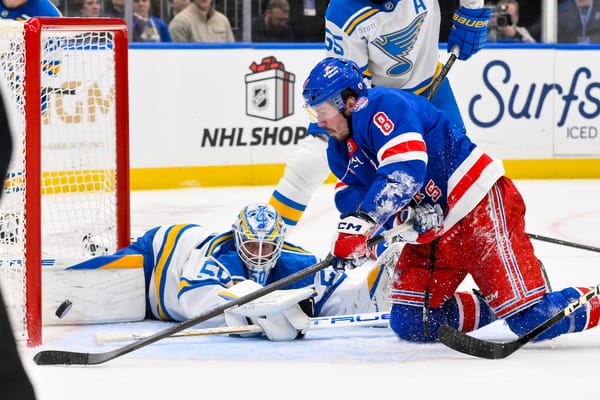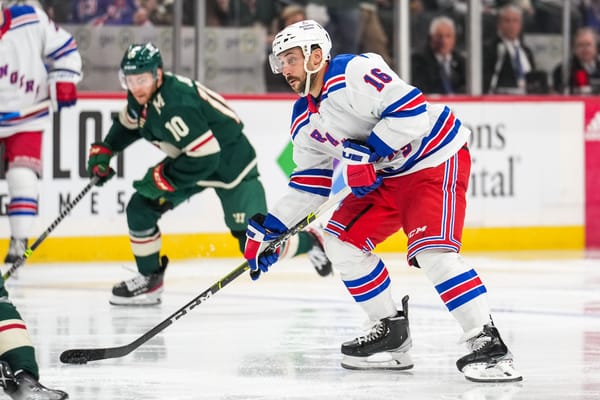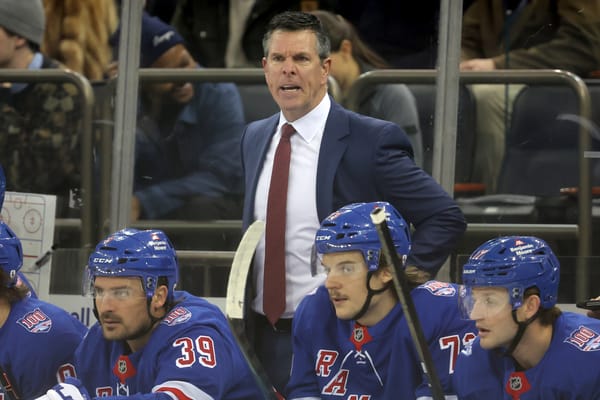Reflecting on past performances of Rangers rookie forwards
To better appreciate what happens next, let’s look at what’s already happened
The New York Rangers are just weeks away from drafting second overall in the 2019 Draft. The Garden Faithful are understandably buzzing about the potential impact of adding Jack Hughes or Kaapo Kakko. Whichever player the Rangers “end up” with with the second overall pick will be an NHL-ready forward.
To state the obvious: that’s a pretty big deal.
The Rangers haven’t taken a forward prospect inside the first five picks of the draft since 1999 (Pavel Brendl). However, they have taken a few forwards later in the first round. Since the 1993-94 season, New York has taken a total of 12 forwards off the board in the 1st round. Obviously, there is a dramatic difference between a prospect that is taken second overall compared to a player taken 10th or 20th overall. To get a better idea of what that difference looks like specifically for the Rangers, let’s take a look at some of their history.
Before we go any further, we need to address the tragic death of Alexei Cherepanov. Cherepanov, the 17th pick of the 2007 Draft, passed away on the bench in a KHL game. For the purpose of getting a clearer picture of how Rangers rookie forwards have panned out, we’ll be excluding him from our numbers from here on in. We’ll also exclude Vitali Kravtsov, who the Rangers picked with the ninth overall pick in the 2018 draft, as he’s yet to make his NHL debut.
So, we are looking at 10 forwards that the Rangers drafted in the first round between the 1993 and 2017 Drafts. The most productive rookie season from that group belongs to Chris Kreider. The big, speedy winger had 37 points in 66 games back in 2013-14, which translates to about 46 points in an 82 game season. Filip Chytil’s 23 points last year comes in a distant second. After Chytil, we have to go all the way back to the 1995-96 season when former 8th overall pick Niklas Sundstrom put up 21 points in 82 games.
In the interest of working with a larger sample size, we can add Kevin Hayes, Brett Howden, Nicklas Jensen, Barrett Heisten, and Rico Fata to that group of former 1st round forwards who played their rookie seasons in New York. All five were first round selections of other teams.
Hayes’ 45-point year in 2014-15 stands head and shoulders above the rest of that group and is nearly level with Kreider’s rookie campaign. In fact, Hayes’ debut season was the best from a Rangers rookie forward since the unheralded Petr Prucha burst onto the scene with 30 goals and 17 assists in 66 games back in 2004-05.
Curious about the top rookie season from any Rangers forward (and not just the first rounders) over the last quarter century? It belongs to Mike York. As a member of the “FLY” line with Theoren Fleury and Eric Lindros, York notched 50 points in the 1999-00 campaign. Not bad for the 136th pick of the 1997 Draft.
York is just one of three Rangers’ rookie forwards to score 20 goals in a season over the last quarter of a century — the other two are Prucha and Derek Stepan. That fact alone illustrates just how long it’s been since the Blueshirts have had a truly elite rookie forward in the lineup. It also highlights how rare big seasons from rookie forwards really are, regardless of whether or not they were drafted and where they went in the draft.
With the exception of Brendl, the Rangers haven’t selected a forward in the first five picks of the draft in over 50 years. Pair that with the number of first round picks the team has traded away, and it’s clear why the organization has struggled to produce first line talent.
Now, let’s take a look at the bigger picture.
Since the 2005-06 season, 239 forwards who were selected in the first round have played their rookie seasons in the NHL. Only 79 of those players had at least 35-points as rookies; 48 of them scored at least 20 goals. Not all first round picks are created equal.
As you might expect, that ratio looks drastically different when we focus exclusively on second overall picks. Since the 2005 Draft there have been 11 forwards taken second overall; eight of those players eclipsed 35 points in their first NHL seasons. Patrik Laine’s 64-point debut for the Winnipeg Jets was the best rookie performance of that group.
Forwards Drafted 2nd Overall since the 2005 Draft
| Draft | Rookie | Age | GP | G | A | Pts | PPP | ESP | SOG | Pts/GP | TOI/GP |
|---|---|---|---|---|---|---|---|---|---|---|---|
| 2005 | Bobby Ryan | 21 | 64 | 31 | 26 | 57 | 23 | 34 | 174 | 0.89 | 15:26 |
| 2006 | Jordan Staal | 18 | 81 | 29 | 13 | 42 | 6 | 27 | 131 | 0.52 | 14:56 |
| 2007 | James van Riemsdyk | 20 | 78 | 15 | 20 | 35 | 7 | 28 | 123 | 0.45 | 12:58 |
| 2010 | Tyler Seguin | 19 | 74 | 11 | 11 | 22 | 3 | 19 | 121 | 0.30 | 12:13 |
| 2011 | Gabriel Landeskog | 19 | 82 | 22 | 30 | 52 | 12 | 38 | 270 | 0.63 | 18:37 |
| 2013 | Aleksander Barkov | 18 | 54 | 8 | 16 | 24 | 6 | 18 | 87 | 0.44 | 17:06 |
| 2014 | Sam Reinhart | 20 | 79 | 23 | 19 | 42 | 10 | 32 | 165 | 0.53 | 16:50 |
| 2015 | Jack Eichel | 19 | 81 | 24 | 32 | 56 | 21 | 35 | 238 | 0.69 | 19:07 |
| 2016 | Patrik Laine | 18 | 73 | 36 | 28 | 64 | 14 | 50 | 204 | 0.88 | 17:55 |
| 2017 | Nolan Patrick | 19 | 73 | 13 | 17 | 30 | 8 | 22 | 127 | 0.41 | 13:43 |
| 2018 | Andrei Svechnikov | 18 | 82 | 20 | 17 | 37 | 5 | 32 | 186 | 0.45 | 14:39 |
The fact that Tyler Seguin and Aleksander Barkov had modest debuts in regards to production serves as an important reminder why we shouldn’t put too much weight on boxcar stats for rookie forwards. Now, that doesn’t mean that goals and assist don’t matter. But the development of NHL prospects is as much an art form as it is a science. There’s also a lot more to player evaluation than counting goals, assists, and shots. One needs only look at Chytil’s 23-point campaign last year to appreciate how conspicuous levels of skill and potential don’t always result in points.
While reflecting on the past performances of Rangers rookie forwards and getting an idea of the caliber of player the Rangers are getting at second overall, one can’t help but think of Lias Andersson. In 2017, the Rangers made Andersson their highest drafted forward since Brendl. In fact, he is one of just seven forwards that the Rangers have selected inside of the first ten picks of the draft since 1985.
Andersson’s six points in 42 games as a rookie was definitely a letdown, but he’s not the only young forward who stumbled out of the gate. Nino Niederreiter was the fifth overall pick of the New York Islanders in 2010. In his rookie year, the Swiss winger scored one goal and registered zero assists in 55 games. It’s also worth mentioning that Timo Meier — a former ninth overall pick — had three goals and three assists in his first 34 games in the NHL.
Now, that doesn’t mean that Andersson is going to become Niederreiter or Meier. It simply means that he needs more time. Maybe his game won’t get to where it needs to be for him to become an NHL regular by the end of next season, but there’s no way to know that until he’s given a chance to adjust and elevate his game.
With all of that being said, we can still expect great things from Hughes and Kakko. But we should still pause before putting the weight of the franchise onto the shoulders of whichever player the Devils don’t take first overall.
All data courtesy of hockey-reference.com, NHL.com, and naturalstattrick.com.




